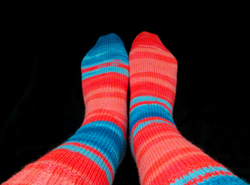Red socks and Blue socks
 A drawer contains a mixture of red socks and blue socks, at most 1950 in all. It so happens that, when two socks are selected randomly without replacement, there is a probability of exactly
2
1
that both are red or both are blue. What is the largest possible number of red socks in the drawer that is consistent with this data?
A drawer contains a mixture of red socks and blue socks, at most 1950 in all. It so happens that, when two socks are selected randomly without replacement, there is a probability of exactly
2
1
that both are red or both are blue. What is the largest possible number of red socks in the drawer that is consistent with this data?
Image Credit: Flickr Alison Clayton .
The answer is 990.
This section requires Javascript.
You are seeing this because something didn't load right. We suggest you, (a) try
refreshing the page, (b) enabling javascript if it is disabled on your browser and,
finally, (c)
loading the
non-javascript version of this page
. We're sorry about the hassle.
2 solutions
I did a recent problem to do this with my University. This is a second way you can do it just like Alan's: Proof: If there is a 1/2 chance of picking a matching pair, the must be an equal number of mismatching pairs. Then, ( 1 r ) ( 1 b ) r b 2 r b r + b r + b = ( 2 r ) + ( 2 b ) = 2 r ( r − 1 ) + 2 b ( b − 1 ) = r 2 − r + b 2 − b = r 2 − 2 r b + b 2 = ( r − b ) 2 Using the rest of Alan's proof finds the number of socks to be: r b = ( 2 n + 1 ) = ( 2 n )
Log in to reply
I also started in a slightly different way: I changed the 1/2 statement to, equivalently, saying that the probability of first picking a red and then picking a black is 1/4. That is to say, 4 r b = ( r + b ) ( r + b − 1 ) , etc.
Oh my god... I answered with the maximum TOTAL. hitting myself right now... Nice solution though. Mine was much less elegant.
There was a similar problem to this one on the 2015 COMC (it was B4) There are n sheep in a barn, where n lies between 2000 and 2100. We split the sheep into 2 barns. We randomly pick two sheep: the probability that both of them are in different barns is exactly 1/2. Determine n.
Let there be r and b red and blue socks respectively. Since we want to find the maximum number of red socks, we can assume WLOG that r ≥ b . Thus, the probability of selecting both red or both blue is ( 2 r + b ) ( 2 r ) + ( 2 b ) = 2 1 ⟹ ( r − b ) 2 = r + b
This implies that r + b is a perfect square, let this be n 2 . Thus we have r + b r − b r = n 2 = n = 2 n 2 + n
Now by the condition, we have that n 2 ≤ 1 9 5 0 . The greatest integer n can be is 4 4 . Plugging this in, we find that r = 9 9 0 . We check to see that this is indeed a solution.